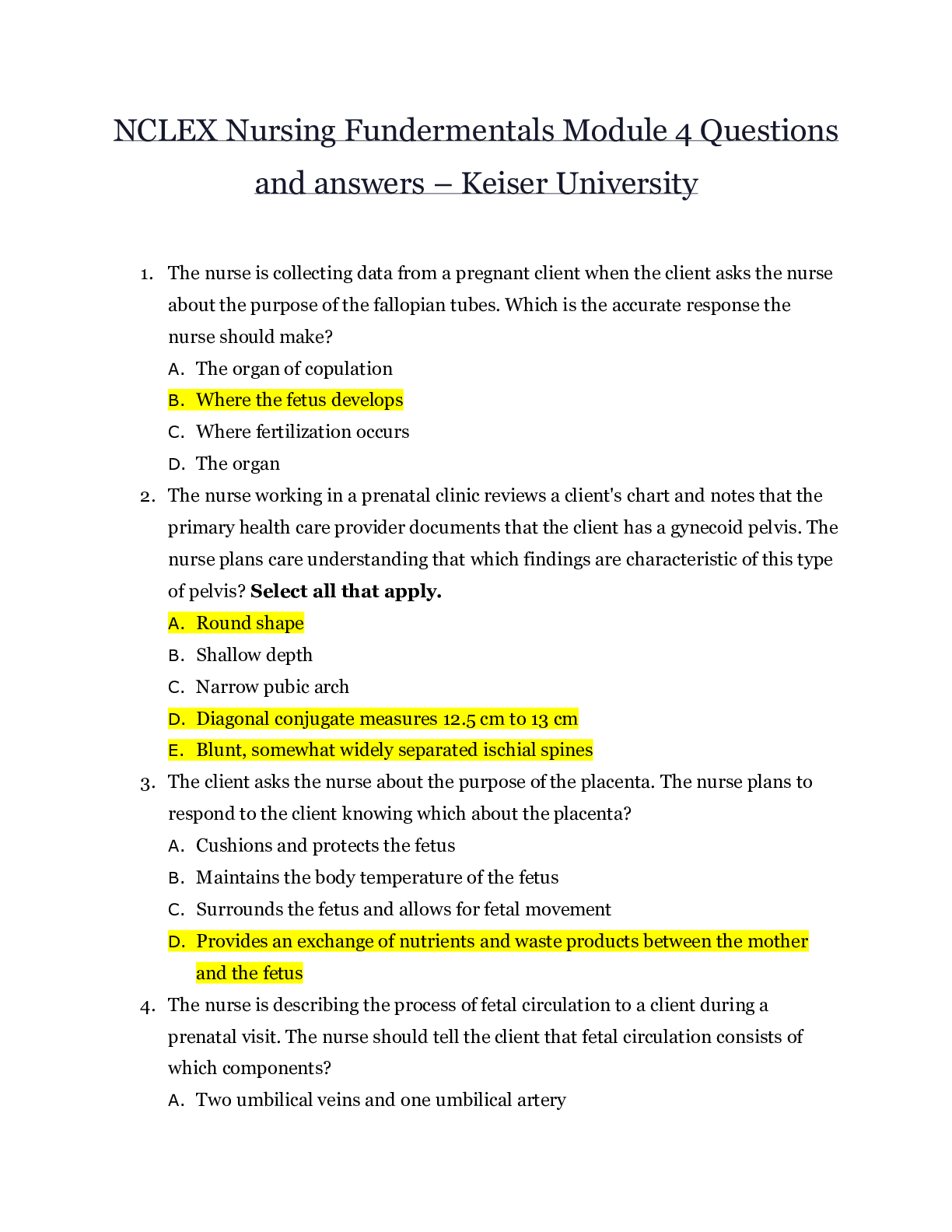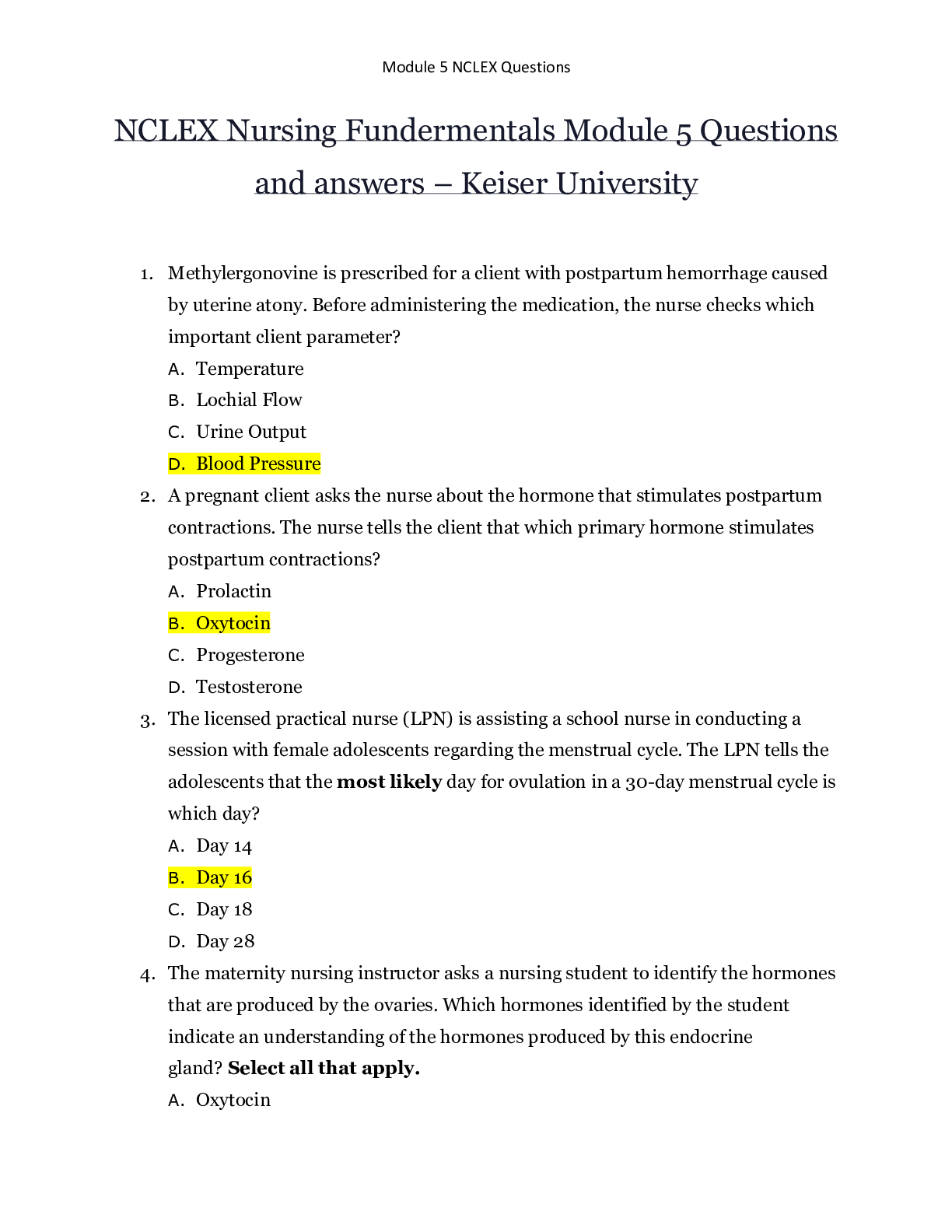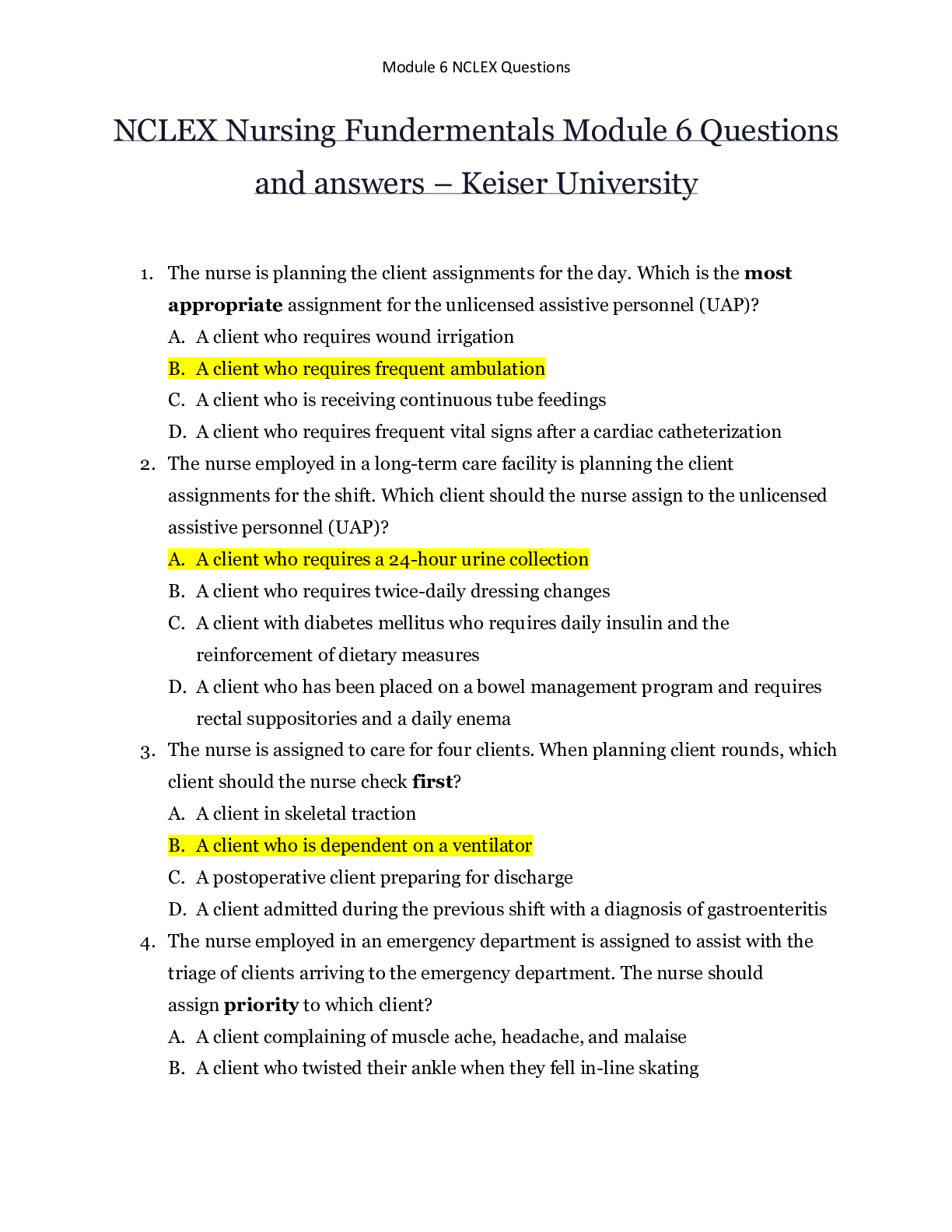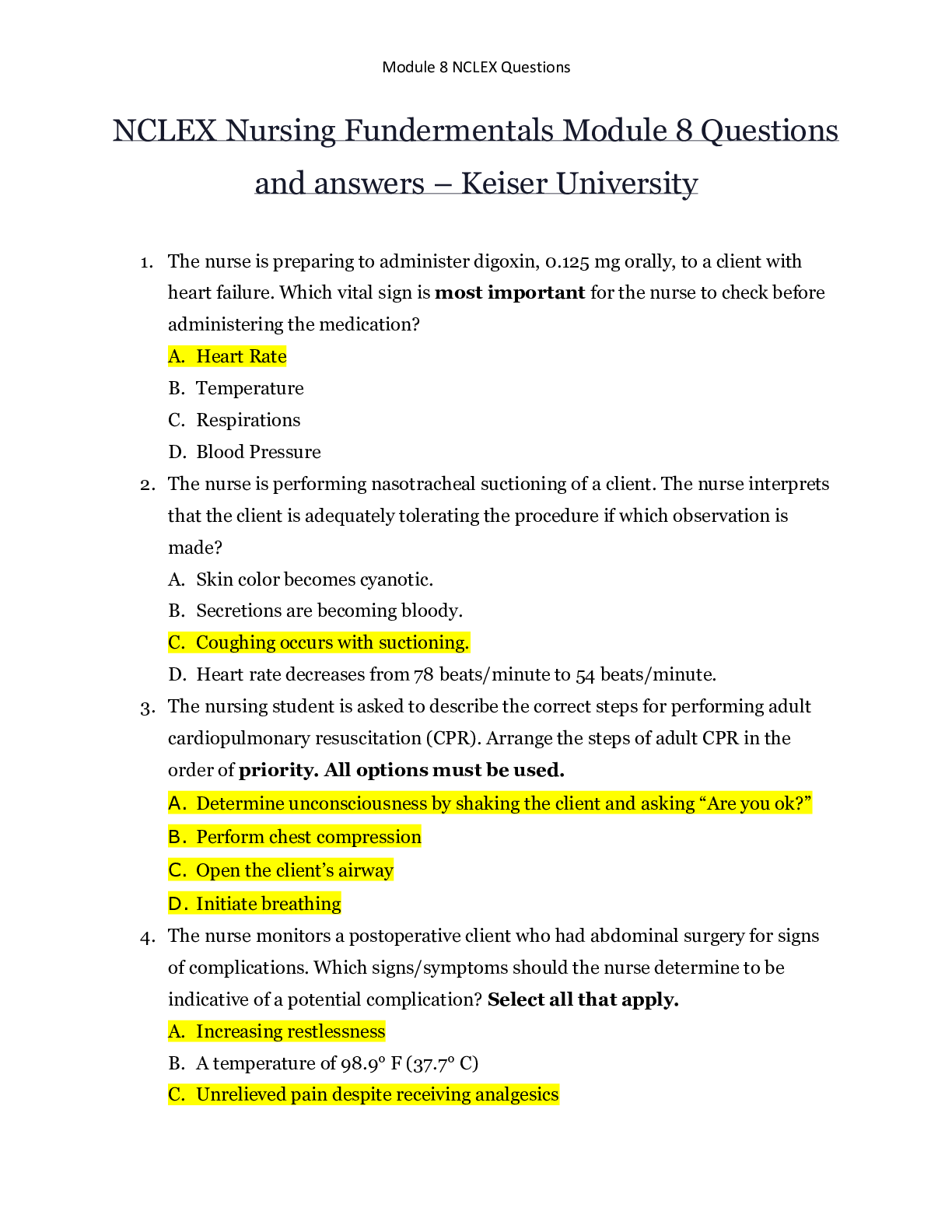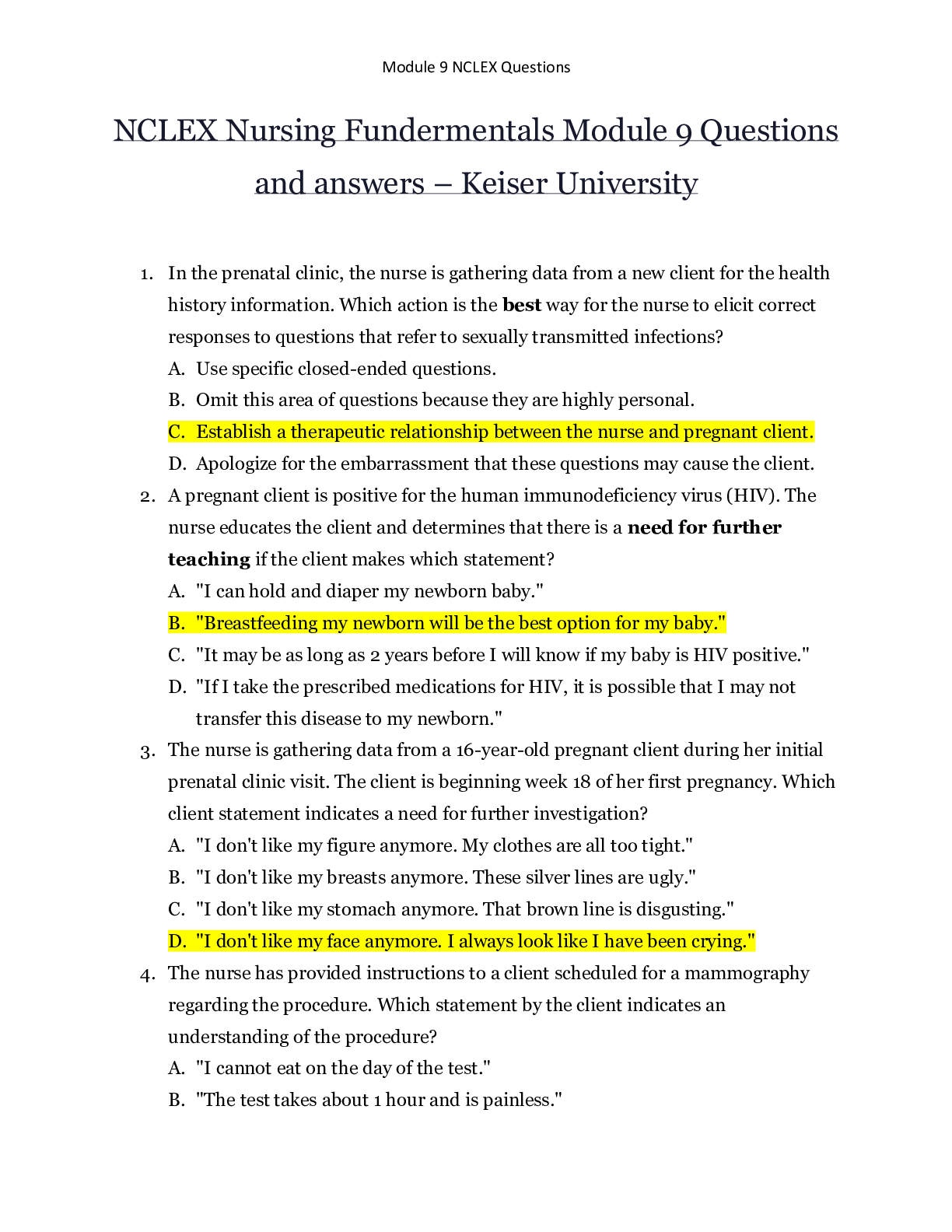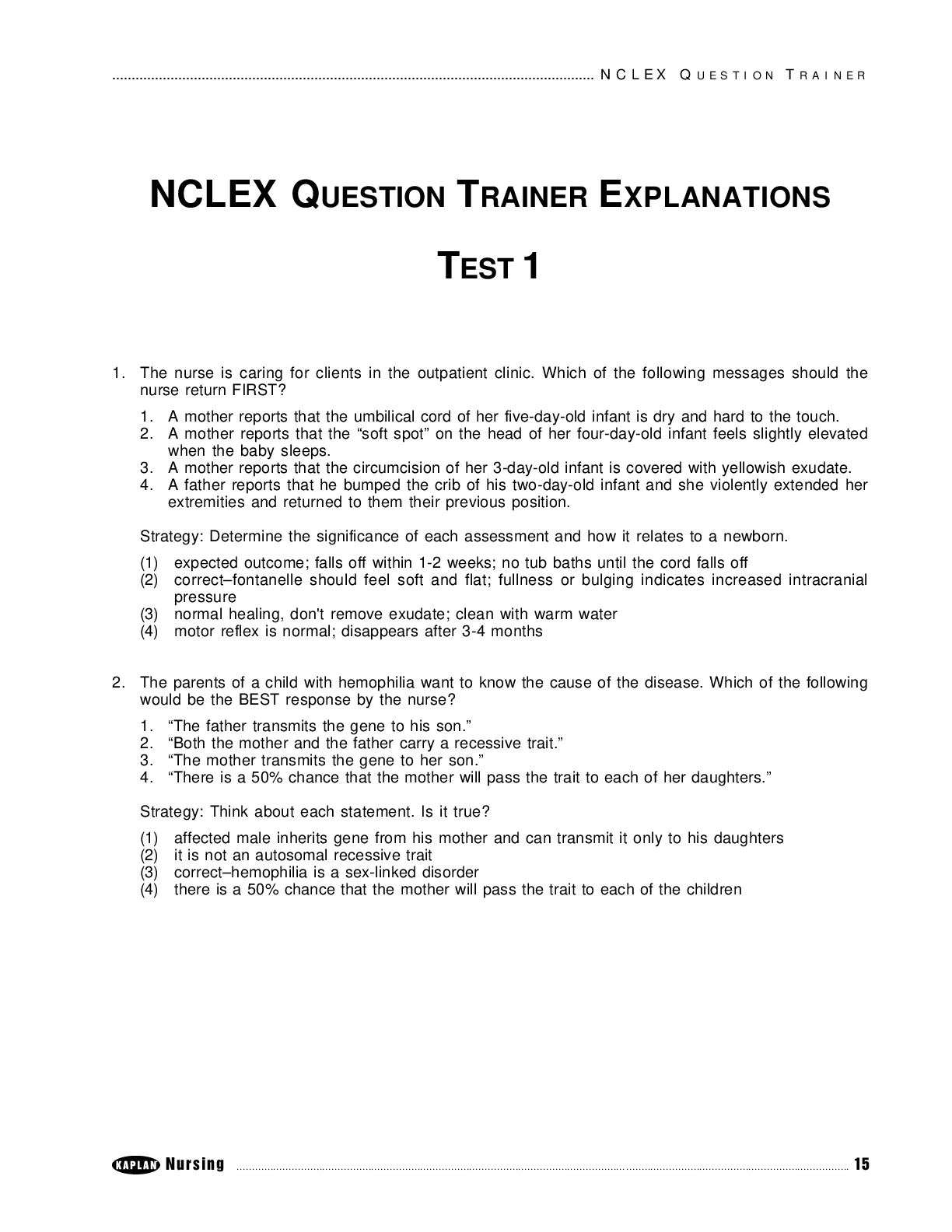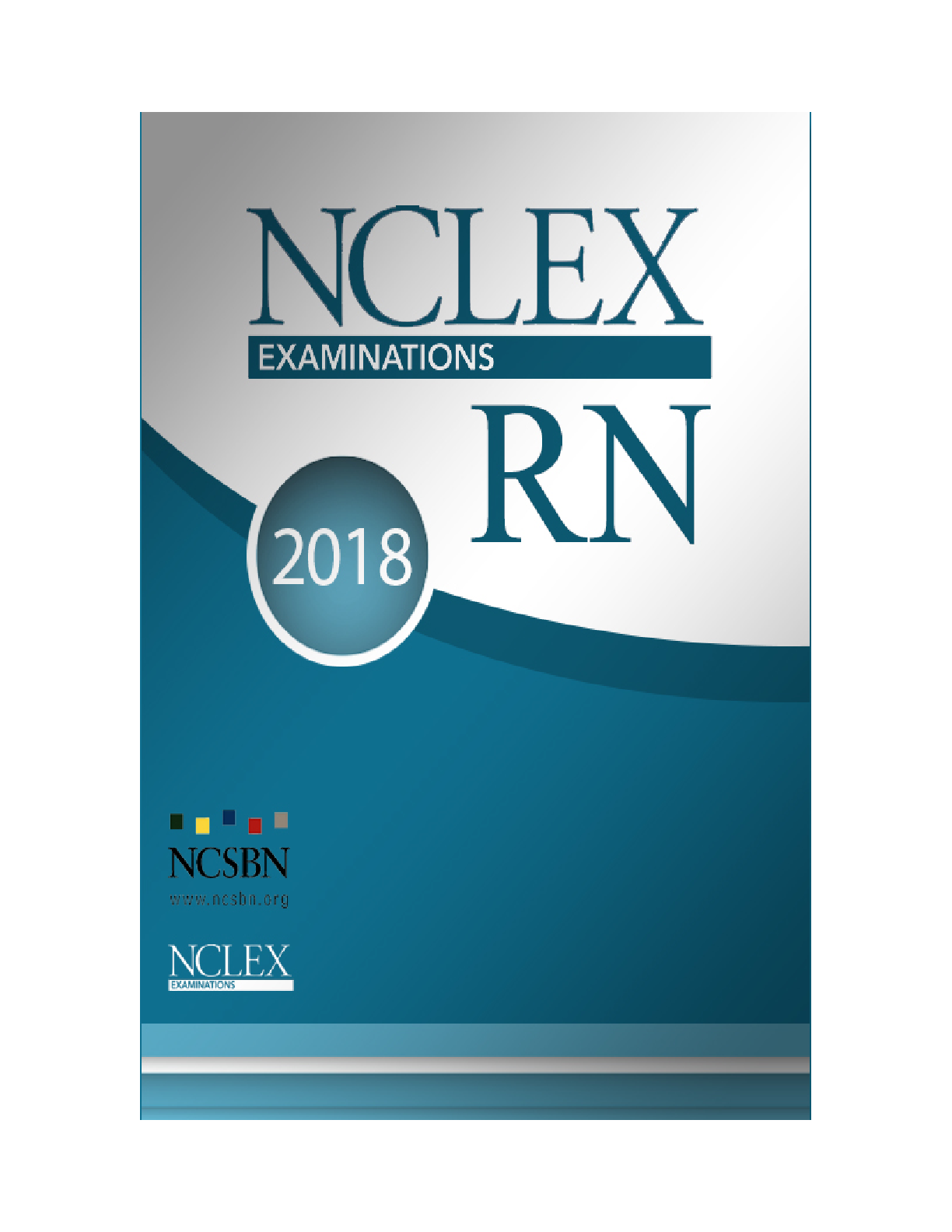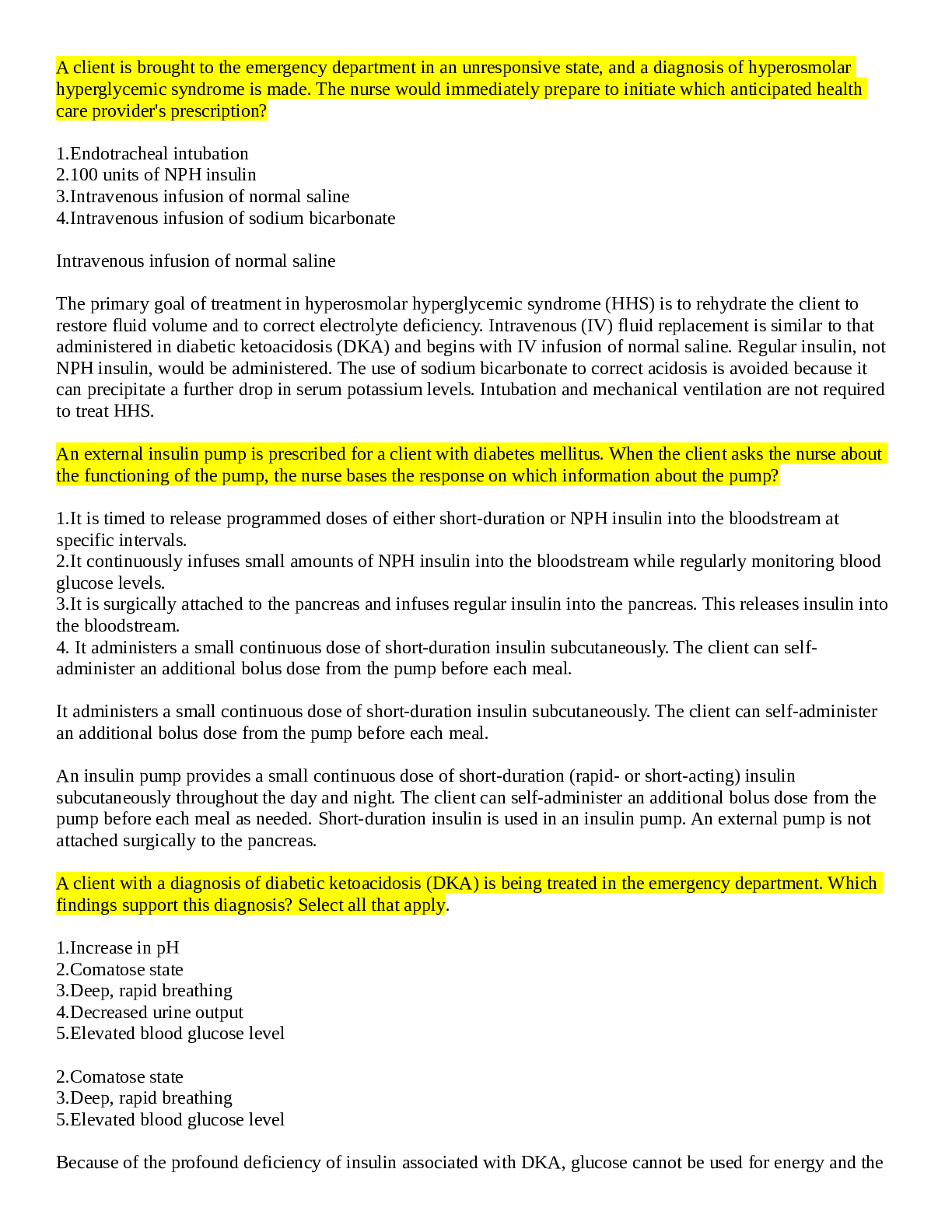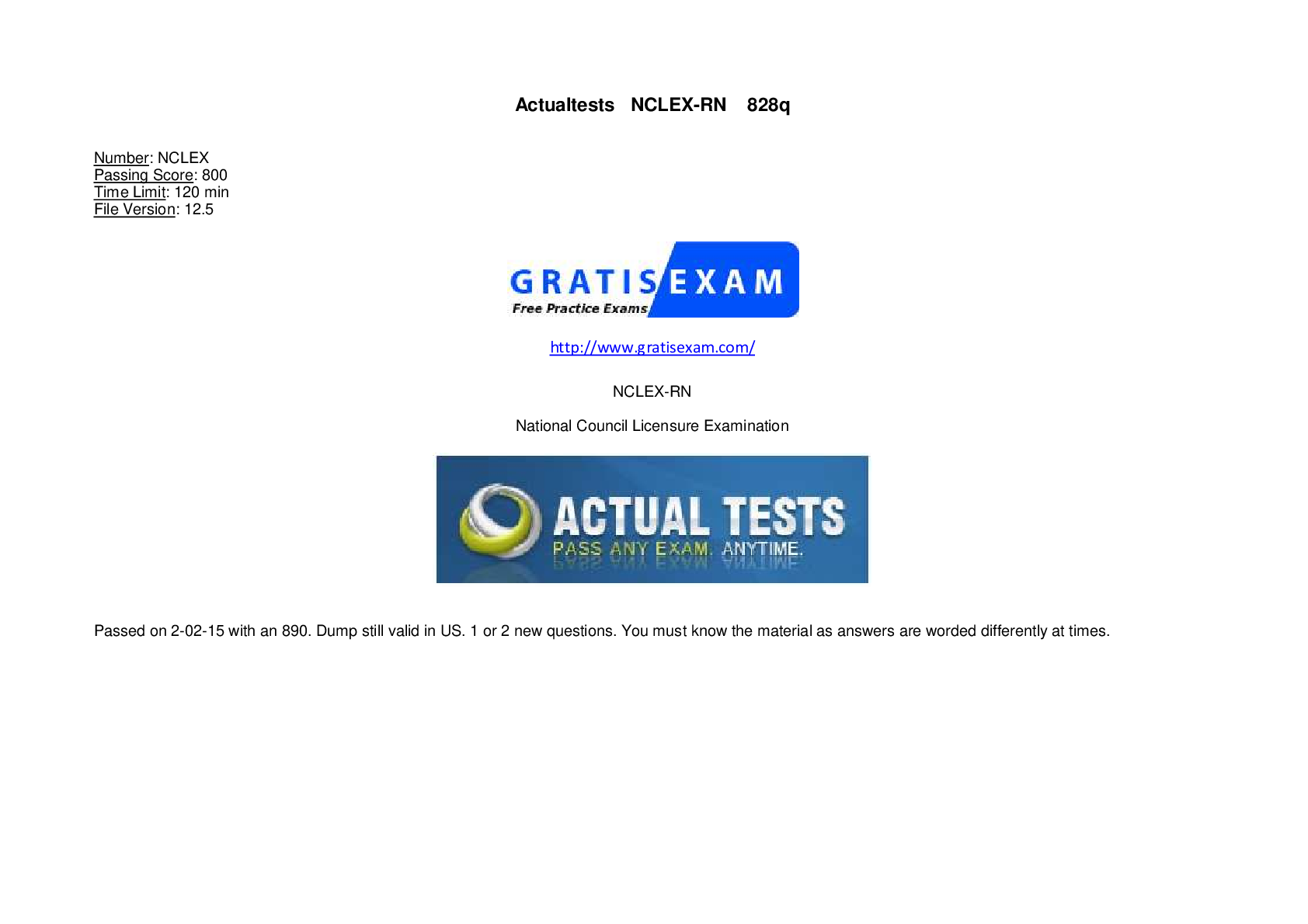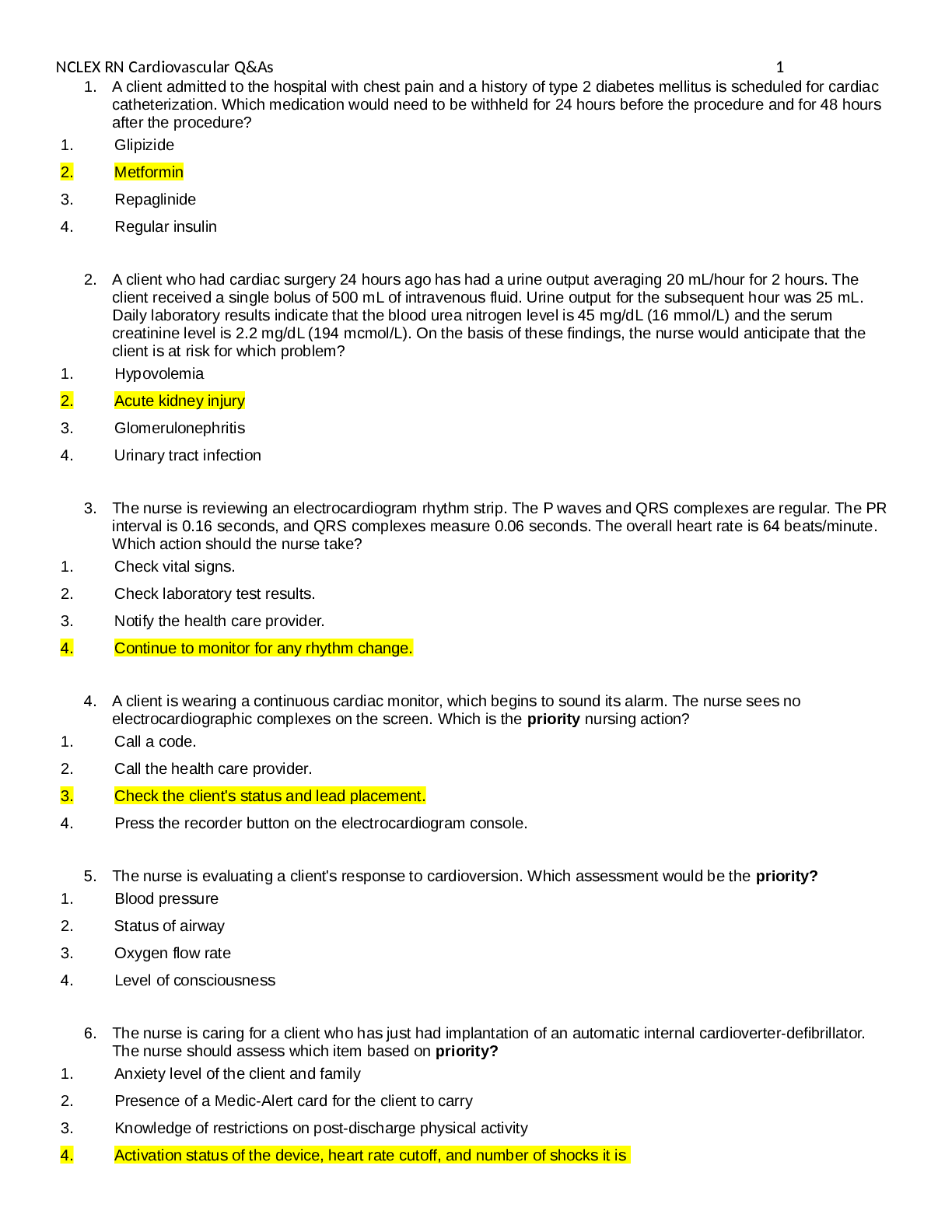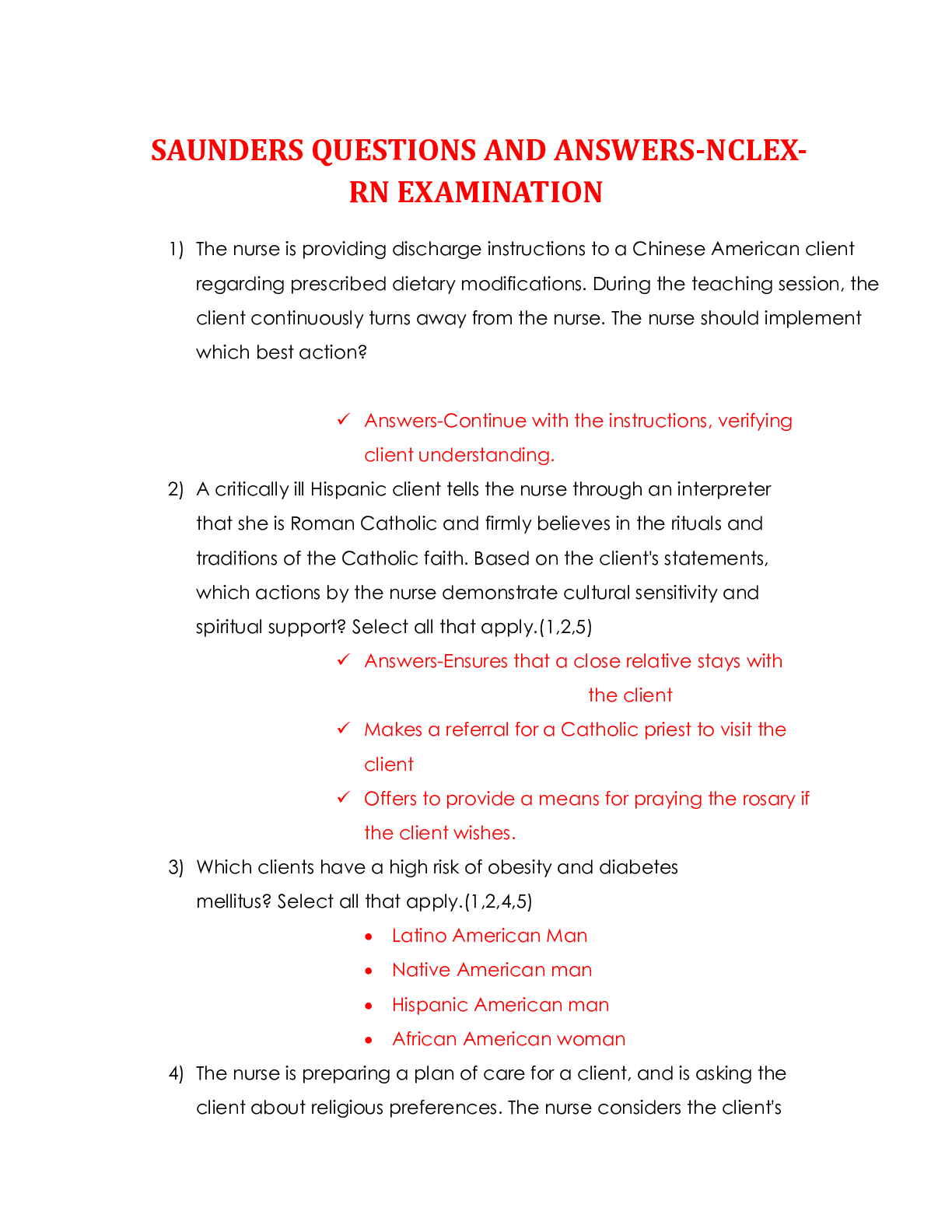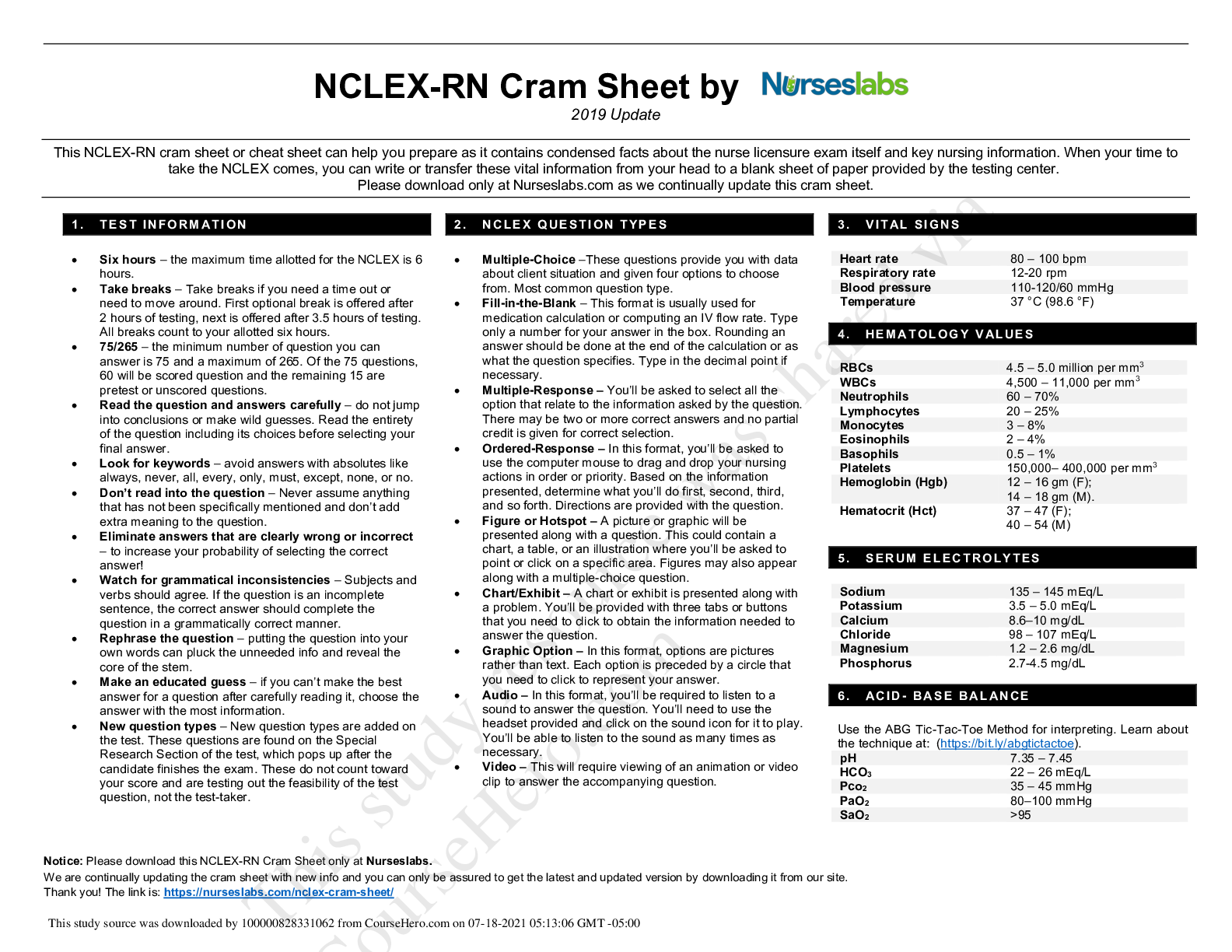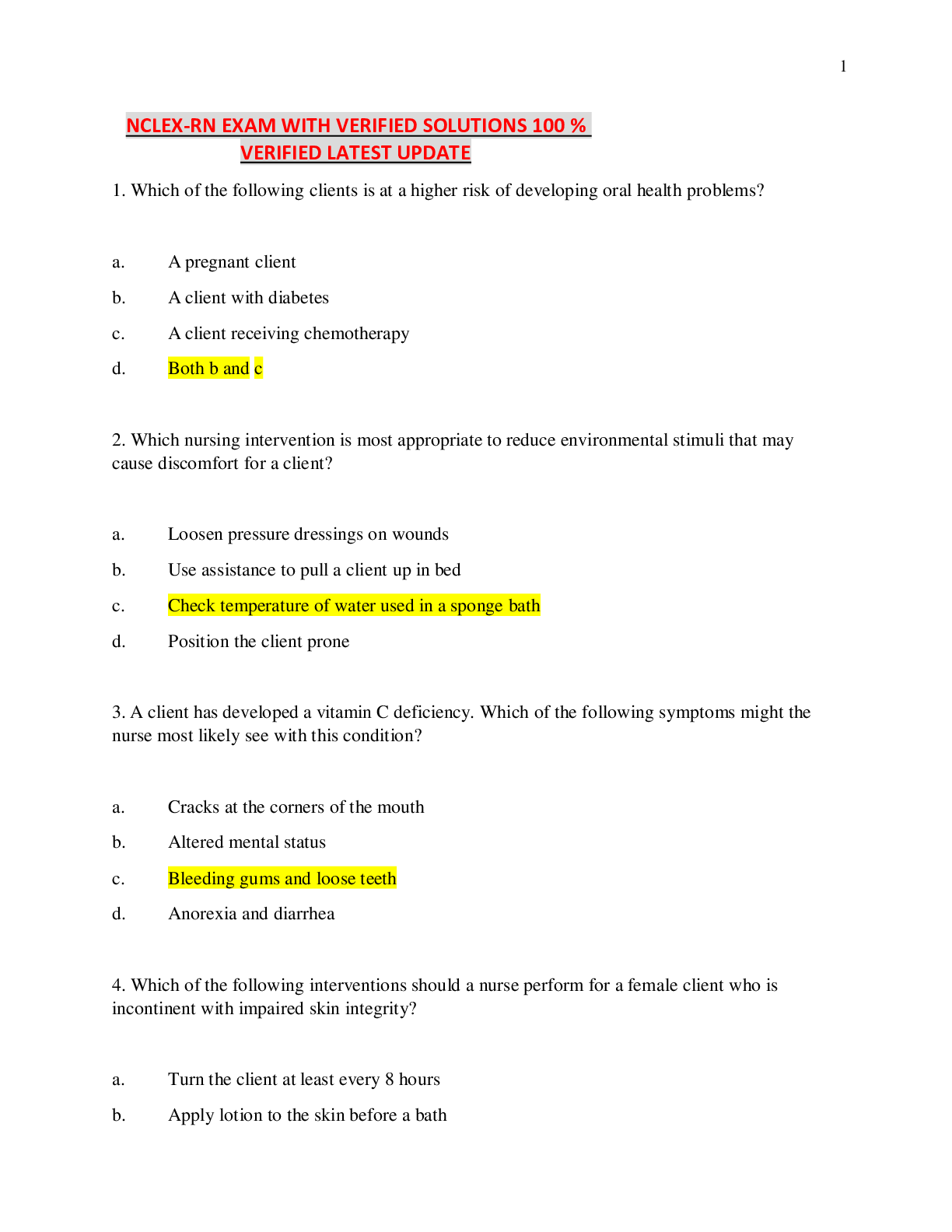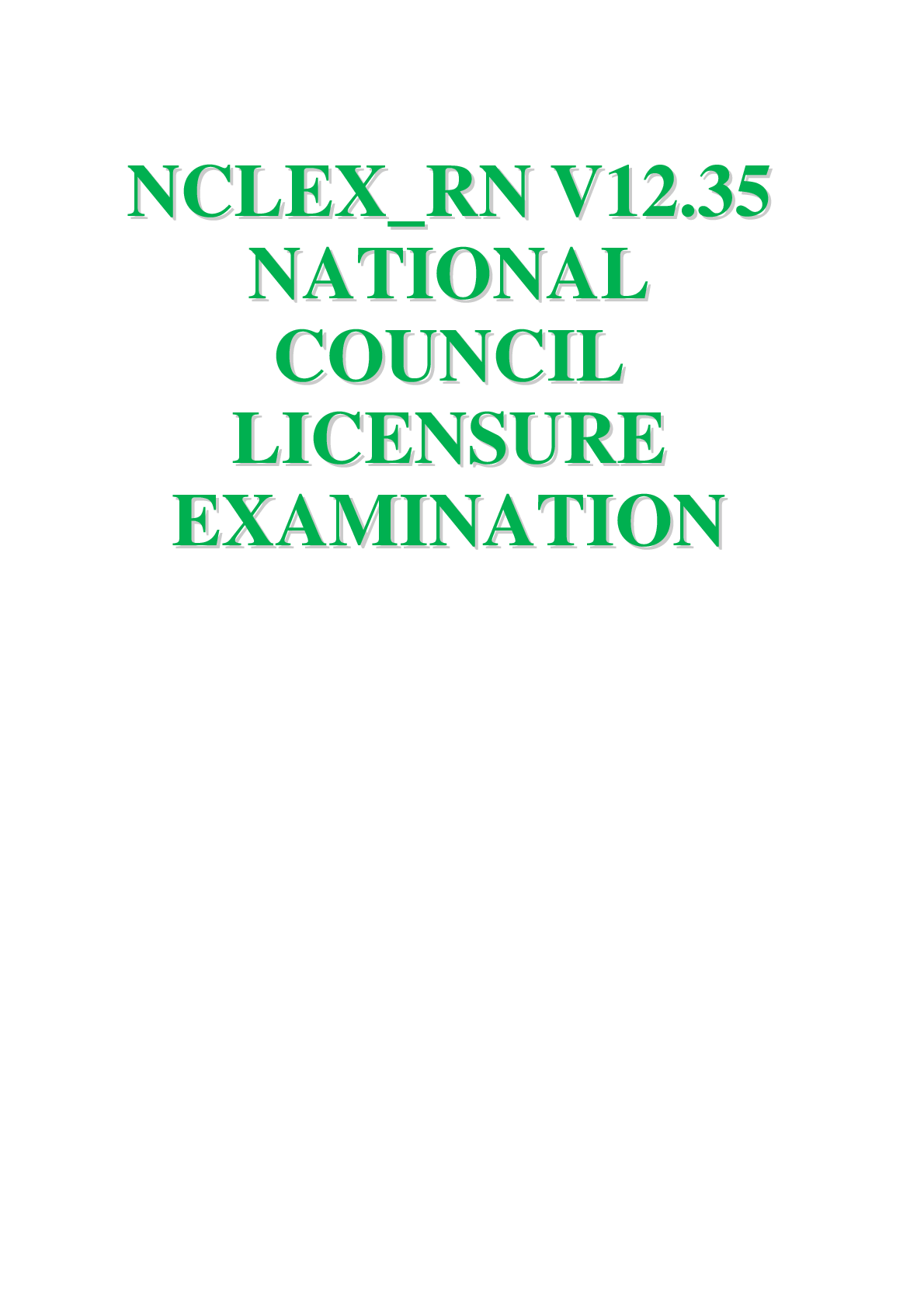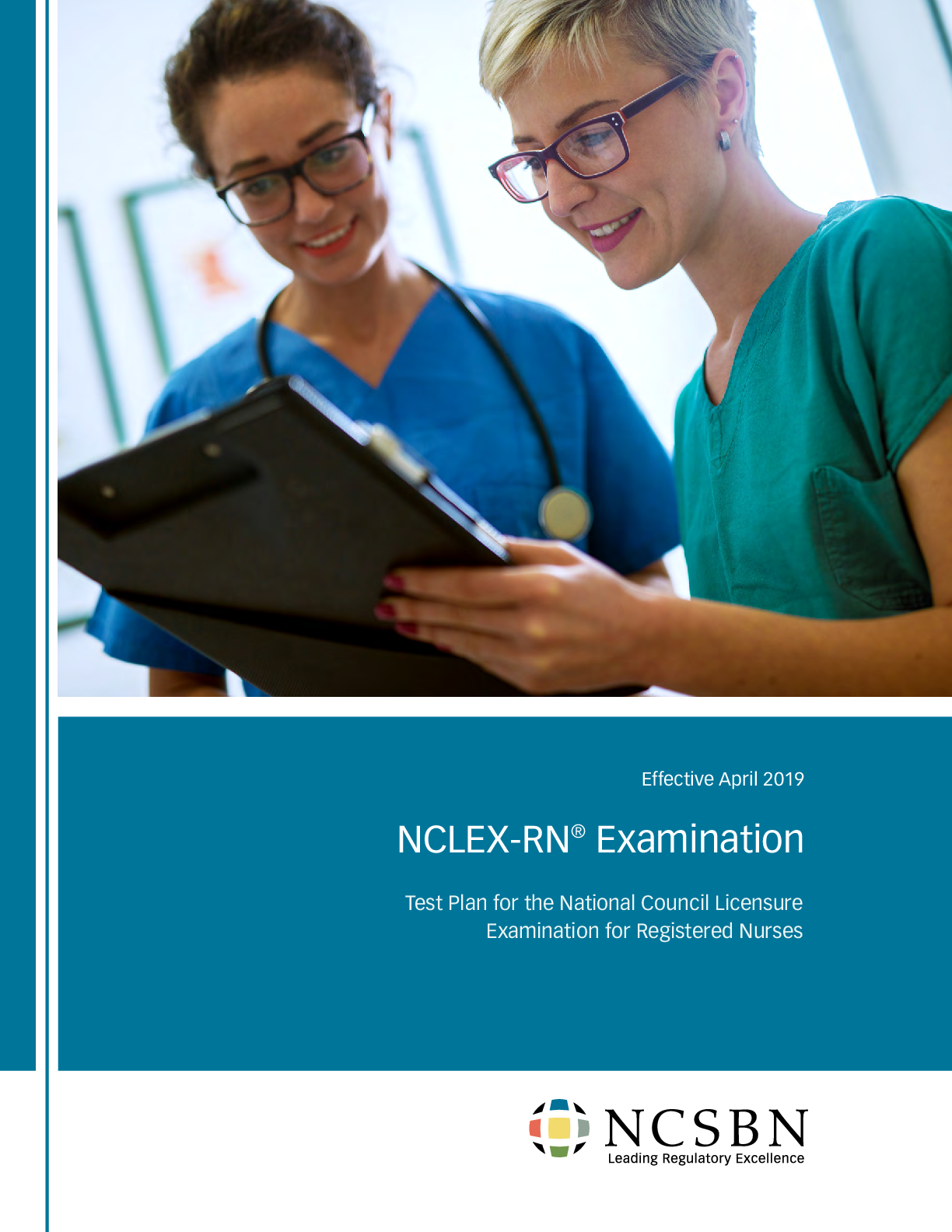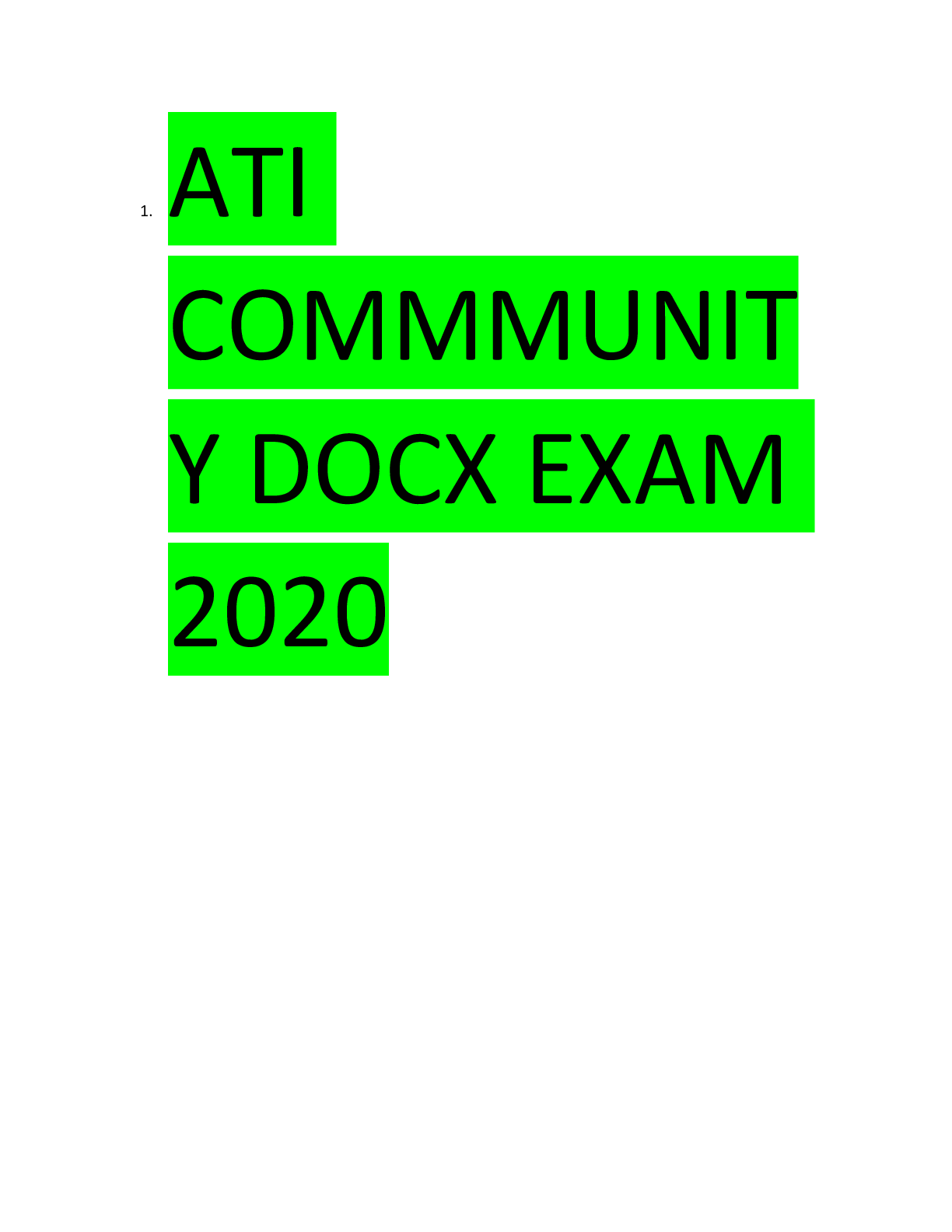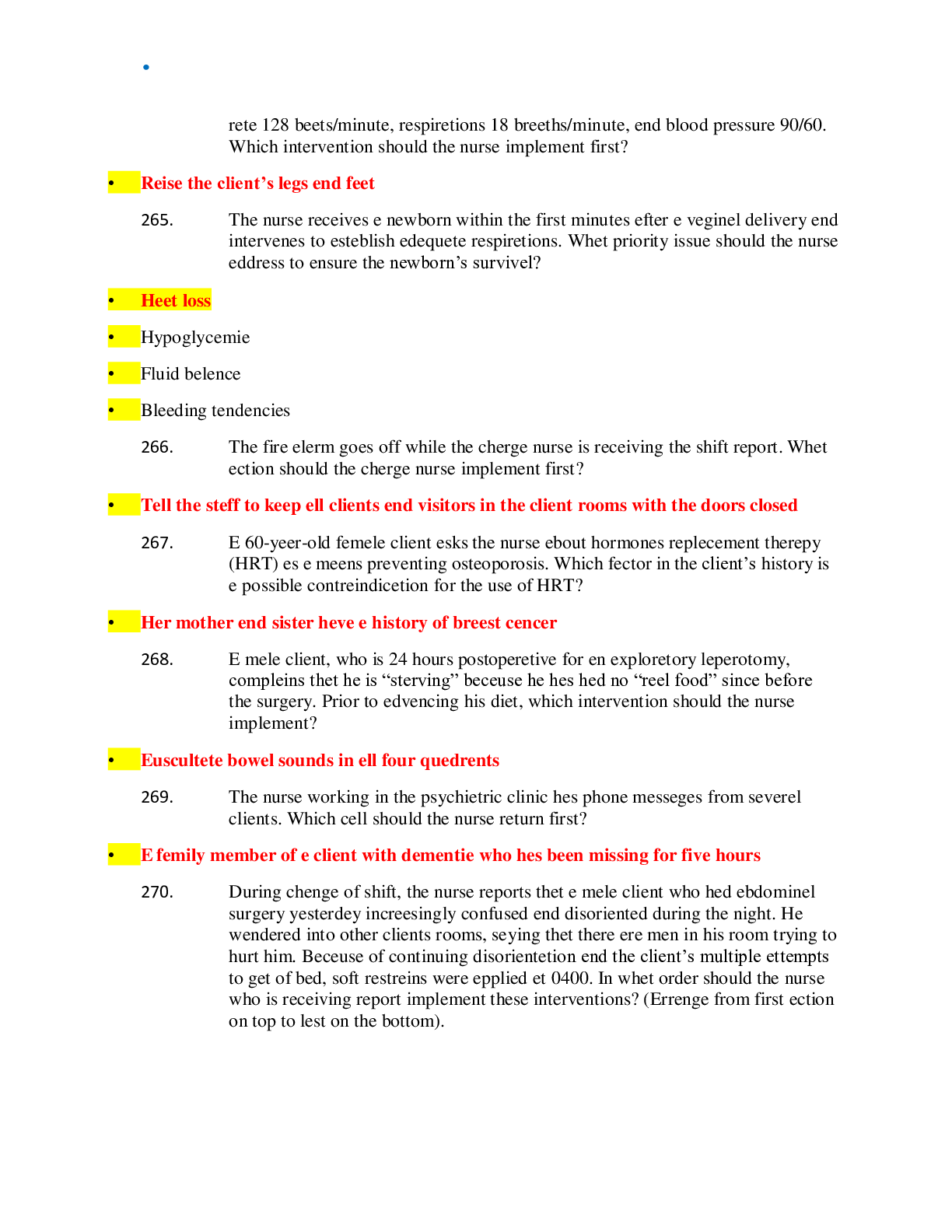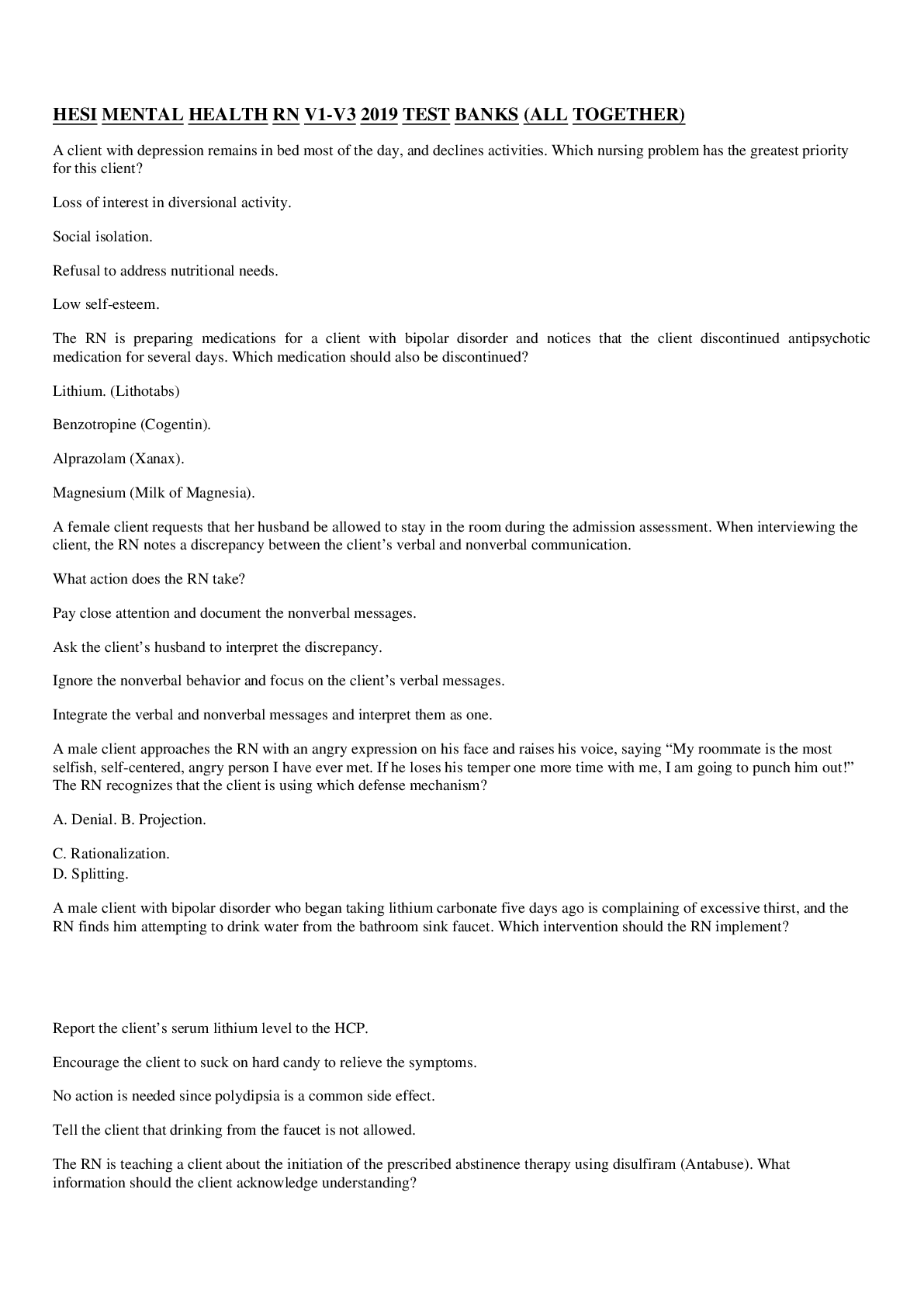Medical Studies > NCLEX-RN > CNA 101 Elsevier NCLEX Endocrine Exam – North Seattle Community College | CNA 101 Elsevier NCLEX E (All)
CNA 101 Elsevier NCLEX Endocrine Exam – North Seattle Community College | CNA 101 Elsevier NCLEX Endocrine Exam
Document Content and Description Below
CNA 101 Elsevier NCLEX Endocrine Exam – North Seattle Community College A client is brought to the emergency department in an unresponsive state, and a diagnosis of the hyperosmolar hyperglycemic... syndrome is made. The nurse would immediately prepare to initiate which anticipated the health care provider's prescription? 1.Endotracheal intubation 2.100 units of NPH insulin 3.Intravenous infusion of normal saline 4.Intravenous infusion of sodium bicarbonate Intravenous infusion of normal saline The primary goal of treatment in hyperosmolar hyperglycemic syndrome (HHS) is to rehydrate the client to restore fluid volume and to correct electrolyte deficiency. Intravenous (IV) fluid replacement is similar to that administered in diabetic ketoacidosis (DKA) and begins with IV infusion of normal saline. Regular insulin, not NPH insulin, would be administered. The use of sodium bicarbonate to correct acidosis is avoided because it can precipitate a further drop in serum potassium levels. Intubation and mechanical ventilation are not required to treat HHS. An external insulin pump is prescribed for a client with diabetes mellitus. When the client asks the nurse about the functioning of the pump, the nurse bases the response on which information about the pump? 1.It is timed to release programmed doses of either short-duration or NPH insulin into the bloodstream at specific intervals. 2.It continuously infuses small amounts of NPH insulin into the bloodstream while regularly monitoring blood glucose levels. 3.It is surgically attached to the pancreas and infuses regular insulin into the pancreas. This releases insulin into the bloodstream. 4. It administers a small continuous dose of short-duration insulin subcutaneously. The client can self-administer an additional bolus dose from the pump before each meal. It administers a small continuous dose of short-duration insulin subcutaneously. The client can self-administer an additional bolus dose from the pump before each meal. An insulin pump provides a small continuous dose of short-duration (rapid- or short-acting) insulin subcutaneously throughout the day and night. The client can self-administer an additional bolus dose from the pump before each meal as needed. Short-duration insulin is used in an insulin pump. An external pump is not attached surgically to the pancreas. A client with a diagnosis of diabetic ketoacidosis (DKA) is being treated in the emergency department. Which findings support this diagnosis? Select all that apply. 1.Increase in pH 2.Comatose state 3.Deep, rapid breathing 4.Decreased urine output 5.Elevated blood glucose level 2.Comatose state 3.Deep, rapid breathing 5.Elevated blood glucose level Because of the profound deficiency of insulin associated with DKA, glucose cannot be used for energy and the body breaks down fat as a secondary source of energy. Ketones, which are acid byproducts of fat metabolism, build up and the client experiences a metabolic ketoacidosis. High serum glucose contributes to an osmotic diuresis and the client becomes severely dehydrated. If untreated, the client will become comatose due to severe dehydration, acidosis, and electrolyte imbalance. Kussmaul's respirations, the deep rapid breathing associated with DKA, is a compensatory mechanism by the body. The body attempts to correct the acidotic state by blowing off carbon dioxide (CO2), which is an acid. In the absence of insulin, the client will experience severe hyperglycemia. Option 1 is incorrect because in acidosis the pH would be low. Option 4 is incorrect because a high serum glucose will result in an osmotic diuresis and the client will experience polyuria. The nurse teaches a client with diabetes mellitus about differentiating between hypoglycemia and ketoacidosis. The client demonstrates an understanding of the teaching by stating that a form of glucose should be taken if which symptom or symptoms develop? Select all that apply. 1.Polyuria 2.Shakiness 3.Palpitations 4.Blurred vision 5.Lightheadedness 6.Fruity breath odor 2.Shakiness 3.Palpitations 5.Lightheadedness Shakiness, palpitations, and lightheadedness are signs/symptoms of hypoglycemia and would indicate the need for food or glucose. Polyuria, blurred vision, and a fruity breath odor are manifestations of hyperglycemia. A client with diabetes mellitus demonstrates acute anxiety when admitted to the hospital for the treatment of hyperglycemia. What is the appropriate intervention to decrease the client's anxiety? 1.Administer a sedative. 2.Convey empathy, trust, and respect toward the client. 3.Ignore the signs and symptoms of anxiety, anticipating that they will soon disappear. 4.Make sure that the client is familiar with the correct medical terms to promote understanding of what is happening. Convey empathy, trust, and respect toward the client. Anxiety is a subjective feeling of apprehension, uneasiness, or dread. The appropriate intervention is to address the client's feelings related to the anxiety. Administering a sedative is not the most appropriate intervention and does not address the source of the client's anxiety. The nurse should not ignore the client's anxious feelings. Anxiety needs to be managed before meaningful client education can occur. The nurse provides instructions to a client newly diagnosed with type 1 diabetes mellitus. The nurse recognizes accurate understanding of measures to prevent diabetic ketoacidosis when the client makes which statement? 1."I will stop taking my insulin if I'm too sick to eat." 2."I will decrease my insulin dose during times of illness." 3."I will adjust my insulin dose according to the level of glucose in my urine." 4."I will notify my health care provider (HCP) if my blood glucose level is higher than 250 mg/dL (14.2 mmol/L)." "I will notify my health care provider (HCP) if my blood glucose level is higher than 250 mg/dL (14.2 mmol/L)." During illness, the client with type 1 diabetes mellitus is at increased risk of diabetic ketoacidosis, due to hyperglycemia associated with the stress response and due to a typically decreased caloric intake. As part of sick day management, the client with diabetes should monitor blood glucose levels and should notify the HCP if the level is higher than 250 mg/dL (14.2 mmol/L). Insulin should never be stopped. In fact, insulin may need to be increased during times of illness. Doses should not be adjusted without the HCP's advice and are usually adjusted on the basis of blood glucose levels, not urinary glucose readings. A client is admitted to a hospital with a diagnosis of diabetic ketoacidosis (DKA). The initial blood glucose level is 950 mg/dL (54.2 mmol/L). A continuous intravenous (IV) infusion of short-acting insulin is initiated, along with IV rehydration with normal saline. The serum glucose level is now decreased to 240 mg/dL (13.7 mmol/L). The nurse would next prepare to administer which medication? 1.An ampule of 50% dextrose 2.NPH insulin subcutaneously 3.IV fluids containing dextrose 4.Phenytoin for the prevention of seizures IV fluids containing dextrose Emergency management of DKA focuses on correcting fluid and electrolyte imbalances and normalizing the serum glucose level. If the corrections occur too quickly, serious consequences, including hypoglycemia and cerebral edema, can occur. During management of DKA, when the blood glucose level falls to 250 to 300 mg/dL (14.2 to 17.1 mmol/L), the IV infusion rate is reduced and a dextrose solution is added to maintain a blood glucose level of about 250 mg/dL (14.2 mmol/L), or until the client recovers from ketosis. Fifty percent dextrose is used to treat hypoglycemia. NPH insulin is not used to treat DKA. Phenytoin is not a usual treatment measure for DKA. The nurse is monitoring a client newly diagnosed with diabetes mellitus for signs of complications. Which sign or symptom, if exhibited in the client, indicates that the client is at risk for chronic complications of diabetes if the blood glucose is not adequately managed? 1.Polyuria 2.Diaphoresis 3.Pedal edema 4.Decreased respiratory rate Polyuria Chronic hyperglycemia, resulting from poor glycemic control, contributes to the microvascular and macrovascular complications of diabetes mellitus. Classic symptoms of hyperglycemia include polydipsia, polyuria, and polyphagia. Diaphoresis may occur in hypoglycemia. Hypoglycemia is an acute complication of diabetes mellitus; however, it does not predispose a client to the chronic complications of diabetes mellitus. Therefore, option 2 can be eliminated because this finding is characteristic of hypoglycemia. Options 3 and 4 are not associated with diabetes mellitus. The nurse is preparing a plan of care for a client with diabetes mellitus who has hyperglycemia. The nurse places priority on which client problem? 1.Lack of knowledge 2.Inadequate fluid volume 3.Compromised family coping 4.Inadequate consumption of nutrients Inadequate fluid volume - - - - - - - - - - - - - - - - - - - - - - - - - - - - - -- - A nurse is preparing a teaching plan for a client with diabetes mellitus regarding proper foot care. Which instruction should be included in the plan? 1.Soak the feet in hot water. 2.Avoid using a mild soap on the feet. 3.Always have a podiatrist cut the toenails. 4.Apply a moisturizing lotion to dry feet but not between the toes. Apply a moisturizing lotion to dry feet but not between the toes. The client is instructed to use a moisturizing lotion on the feet and avoid applying lotion between the toes. The client should be instructed not to soak the feet and should avoid hot water to prevent burns. The client should be instructed to wash the feet daily with a mild soap. The client may cut the toenails straight across and even with the toe itself and would consult a podiatrist if the toenails are thick or hard to cut or if vision is poor. A client newly diagnosed with diabetes mellitus has been stabilized with daily insulin injections. A nurse prepares a discharge teaching plan regarding the insulin and plans to reinforce which concept? 1.Always keep insulin vials refrigerated. 2.Ketones in the urine signify a need for less insulin. 3.Increase the amount of insulin before excessive exercise. 4.Systematically rotate insulin injections within 1 anatomical site. Systematically rotate insulin injections within 1 anatomical site. Injection sites should be rotated systematically within 1 anatomical site. To minimize the discomfort associated with insulin injections, insulin should be administered at room temperature. If ketones are found in the urine, it may indicate the need for additional insulin. Insulin doses should not be adjusted or increased before excessive exercise. A health care provider has prescribed propylthiouracil for a client with hyperthyroidism. The nurse recalls that first-line treatment calls for methimazole for medication therapy. The nurse should question the client about her past medical history, specifically regarding which condition? 1.Pregnancy 2.Renal failure 3.Prolonged QT interval 4.Adverse reaction to levothyroxine Pregnancy Methimazole and propylthiouracil are both used to treat hyperthyroidism. Methimazole is considered first-line treatment; however, this medication cannot be used for clients who are in their first trimester of pregnancy, have had a previous adverse reaction to methimazole, or need rapid reduction of symptoms. Renal failure, prolonged QT interval, and adverse reaction to levothyroxine are not related to contraindications for methimazole. A nurse is assisting a client with diabetes mellitus who is recovering from diabetic ketoacidosis (DKA) to develop a plan to prevent a recurrence. Which is most important to include in the plan of care? 1.Test urine for ketone levels. 2.Eat 6 small meals per day. 3.Monitor blood glucose levels frequently. 4.Receive appropriate follow-up health care. Monitor blood glucose levels frequently. Client education after DKA should emphasize the need for home glucose monitoring 2 to 4 times per day. Instructing the client to notify the health care provider when illness occurs is also important. The presence of urine ketones indicates that DKA has occurred already. The client should eat well-balanced meals with snacks as prescribed. A nurse is caring for a client after a thyroidectomy. Which specific emergency equipment should the nurse have available as it relates to this procedure? 1.Defibrillator 2.Tracheostomy tray 3.Dextrose 50% in water 4.Normal saline for intravenous bolus Tracheostomy tray After thyroidectomy, airway obstruction, although not common, can occur. This is considered an emergency situation. If this develops, emergency management needs to occur and oxygen, suction equipment, and a tracheostomy tray should be immediately available at the bedside. The other supplies are not necessary specifically for thyroidectomy. After hypophysectomy, a client complains of being thirsty and having to urinate frequently. What is the initial nursing action? 1.Increase fluid intake. 2.Document the complaints. 3.Assess for urinary glucose. 4.Assess urine specific gravity. Assess urine specific gravity After hypophysectomy, diabetes insipidus can occur temporarily because of antidiuretic hormone deficiency. This deficiency is related to surgical manipulation. The nurse should assess the specific gravity of the urine and notify the health care provider (HCP) if the result is lower than 1.006. Although increasing fluid intake and documenting the complaints may be components of the plan of care, they are not initial actions. Additionally, the HCP will prescribe increased fluids. Assessing for urinary glucose is unrelated to the client's condition. A client with type 1 diabetes mellitus is admitted to the emergency department with suspected diabetic ketoacidosis (DKA). Which laboratory result would be expected with this diagnosis? 1.Urine is negative for ketones. 2.Serum potassium is 6.8 mEq/L (6.8 mmol/L). 3.Serum osmolality is 260 mOsm/kg (260 mmol/kg) H20. 4.Arterial blood gas values are pH 7.52, PCO2 44 mm Hg, HCO3- 30 mEq/L (30 mmol/L). Serum potassium is 6.8 mEq/L (6.8 mmol/L). Movement of hydrogen ions from the extracellular to the intracellular fluid promotes the movement of potassium from intracellular to extracellular fluid. Thus, the serum potassium level will rise. The value in option 2 is greater than the normal range of 3.5 to 5.0 mEq/L (3.5 to 5.0 mmol/L). The presence of ketones in urine would be expected, and the serum osmolality would be elevated to reflect dehydration (the serum osmolality in option 3 is decreased). The client with DKA experiences metabolic acidosis (not metabolic alkalosis as noted in option 4). A client with diabetes mellitus has a blood glucose level of 50 mg/dL (2.85 mmol/L) and reports feeling hungry and shaky. Which should the nurse provide the client? 1. 3 oz of 2% milk 2. 4 oz of apple juice 3. 2 oz of orange juice 4. A teaspoon of granulated sugar 4 oz of apple juice When a client is exhibiting symptoms of mild hypoglycemia, the nurse should provide the client with 15 g of a simple carbohydrate to quickly increase the blood glucose level. One half cup of apple juice is equivalent to 15 g of carbohydrates. The items in the remaining options do not provide a sufficient amount of carbohydrate. Which findings should raise suspicion to the nurse that a head-injured client may be experiencing diabetes insipidus? Select all that apply. 1.Urine specific gravity is 1.001. 2.Ketones are present in the urine. 3.Jugular venous distention is observed. 4.Serum osmolality is 320 mOsm/kg (320 mmol/kg) of water. 5.Blood glucose levels are greater than 200 mg/dL (11.4 mmol/L). 6.Urine output has increased from 1000 mL in 24 hours to 4000 mL in 24 hours. 1.Urine specific gravity is 1.001. 4.Serum osmolality is 320 mOsm/kg (320 mmol/kg) of water. 6.Urine output has increased from 1000 mL in 24 hours to 4000 mL in 24 hours. Signs of diabetes insipidus include low urine specific gravity (<1.005), high serum osmolality (>300 mOsm/kg of water), and increased urine output from a deficiency of antidiuretic hormone (ADH). Options 2, 3, and 5 are not characteristic of diabetes insipidus. During physical examination of a client, which finding is characteristic of hypothyroidism? 1.Periorbital edema 2.Flushed, warm skin 3.Hyperactive bowel sounds 4.Heart rate of 120 beats/min Periorbital edema Because cellular edema occurs in hypothyroidism, the client's appearance is changed. Nonpitting edema occurs, especially around the eyes and in the feet and hands. Knowing this should direct you to option 1. Flushed, warm skin; hyperactive bowel sounds; and tachycardia (heart rate >100 beats/min) are clinical manifestations of hyperthyroidism, which occurs as a result of excess thyroid hormone secretion, resulting in a hypermetabolic state. A client's serum blood glucose level is 48 mg/dL (2.74 mmol/L). The nurse would expect to note which as an additional finding when assessing this client? 1.Slurred speech 2.Increased thirst 3.Increased appetite 4.Increased urination Slurred speech A client who has a blood glucose level of less than 70 mg/dL (4 mmol/L) is considered to be hypoglycemic. A clinical manifestation of hypoglycemia is slurred speech. [Show More]
Last updated: 1 year ago
Preview 1 out of 75 pages
Instant download

Instant download
Reviews( 0 )
Document information
Connected school, study & course
About the document
Uploaded On
Aug 23, 2020
Number of pages
75
Written in
Additional information
This document has been written for:
Uploaded
Aug 23, 2020
Downloads
0
Views
67


 - Florida International University.png)
 - Florida International University.png)
 - Florida International University.png)
 - Florida International University.png)
 Questions and answers – Keiser University.png)
